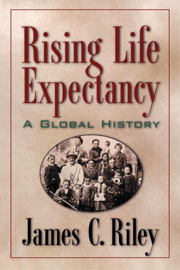Book contents
- Frontmatter
- Dedication
- Contents
- List of Figures, Maps, and Tables
- Preface and Acknowledgments
- Introduction: A Global Revolution in Life Expectancy
- 1 A Brief Overview of the Health Transition
- 2 Public Health
- 3 Medicine
- 4 Wealth, Income, and Economic Development
- 5 Famine, Malnutrition, and Diet
- 6 Households and Individuals
- 7 Literacy and Education
- Conclusion
- Index
1 - A Brief Overview of the Health Transition
Published online by Cambridge University Press: 05 February 2015
- Frontmatter
- Dedication
- Contents
- List of Figures, Maps, and Tables
- Preface and Acknowledgments
- Introduction: A Global Revolution in Life Expectancy
- 1 A Brief Overview of the Health Transition
- 2 Public Health
- 3 Medicine
- 4 Wealth, Income, and Economic Development
- 5 Famine, Malnutrition, and Diet
- 6 Households and Individuals
- 7 Literacy and Education
- Conclusion
- Index
Summary
In some places and times before 1800 life expectancy at birth may have reached or even slightly surpassed forty years. E. A. Wrigley and R. S. Schofield estimate that in England between 1541 and 1871, survival time ranged from a high of 41.7 years (in 1581–85) to a low of 27.8 years (in 1561–65), and averaged 35.5 years. In itself that represented an achievement. England's seventeenth-century population was favored in its survival levels, compared with most others. One of its advantages was to escape mortality crises – famines, epidemics, and wars – earlier than its neighbors. The Japanese, too, seem to have enjoyed atypically high life expectancy in the centuries before the health transition. So did the Nordic people and perhaps also people in some other world regions.
But an expectation of 35 years was unusually high. In France between 1740 and 1790 the life expectancy of males fluctuated between 24 and 28 and of females between 26 and 30 years. In some regions of the world life expectancy at birth did not surpass 20 years. Low values are often an effect of high infant and child mortality. Where life expectancy at birth ranged between 20 and 35 years, the life expectancy of young adults was often much higher, even 35 or 40 years. A heavy toll of infant and child mortality brought survival time from birth down.
- Type
- Chapter
- Information
- Rising Life ExpectancyA Global History, pp. 32 - 57Publisher: Cambridge University PressPrint publication year: 2001
- 1
- Cited by



